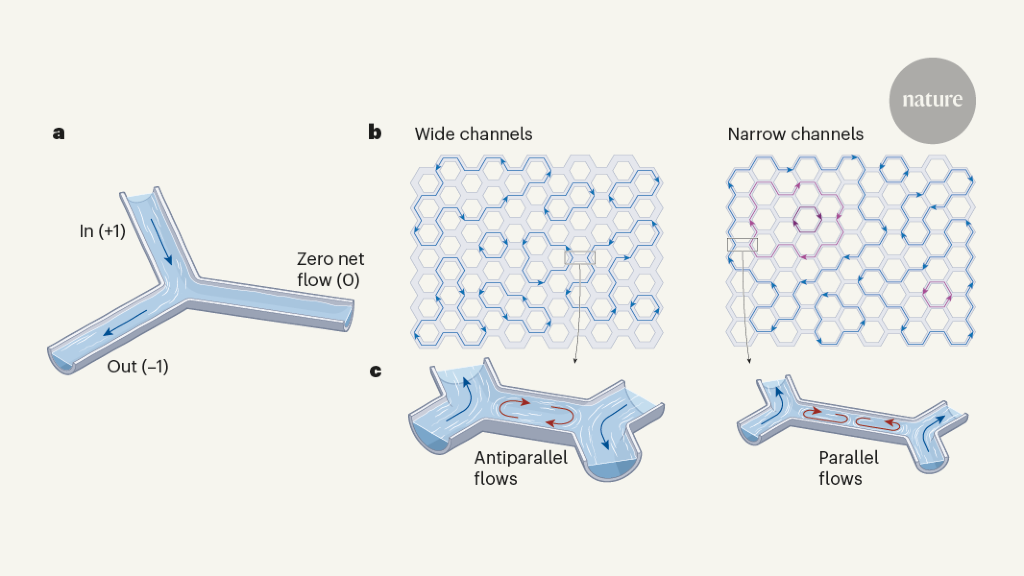Understanding Fluid Dynamics in Vascular Networks
Core Concepts
Active fluids flowing through networks follow specific rules that predict observed patterns, as analyzed by Jorge et al. in Nature Physics.
Abstract
Blood flow in the body's vascular network is governed by conservation of fluid volume, where changes at one node can impact the entire system. Active fluids, like blood, exhibit complex relationships leading to pattern emergence. Jorge et al. studied active fluids in large-scale networks and identified predictive rules for the observed patterns.
Active fluids navigate networks by solving sudoku-like problems
Stats
Conservation of fluid volume ensures sum of flows into each node equals outgoing flows.
Active fluids exhibit complex relationships between flows at different points.
Jorge et al. found rules predicting patterns in active fluids flowing through networks.
Quotes
Key Insights Distilled From
by Mathieu Le V... at www.nature.com 02-06-2024
https://www.nature.com/articles/d41586-024-00277-4
Deeper Inquiries
How do the findings on active fluids navigating networks contribute to medical research
The findings on active fluids navigating networks have significant implications for medical research. Understanding how these self-propelled fluids behave in complex vascular systems can provide insights into various physiological processes within the human body. For instance, by studying how active fluids flow through blood vessels, researchers can gain a better understanding of conditions such as thrombosis, where abnormal blood clotting occurs. This knowledge could lead to the development of more effective treatments or preventive measures for such disorders. Additionally, insights from this research could also help improve drug delivery systems by optimizing the flow of medications through targeted areas in the body.
What challenges might arise when applying these predictive rules to real-world scenarios
While the predictive rules derived from analyzing active fluids flowing through networks offer valuable insights, several challenges may arise when applying them to real-world scenarios. One major challenge is the complexity and variability of biological systems compared to controlled laboratory settings. Biological systems are influenced by numerous factors that can affect fluid dynamics, such as changes in temperature, pressure gradients, and cellular interactions. As a result, predicting fluid behavior accurately in vivo may be challenging due to these dynamic and unpredictable variables.
Another challenge is translating theoretical models based on idealized assumptions into practical applications for clinical use. Real-world applications often require simplifications or approximations that may not fully capture the intricacies of biological processes. Therefore, validating predictive rules derived from theoretical models with experimental data in diverse biological contexts is essential but can be time-consuming and resource-intensive.
How can understanding fluid dynamics in biological systems benefit other scientific fields
Understanding fluid dynamics in biological systems has far-reaching implications beyond medical research and healthcare. Insights gained from studying how fluids navigate intricate networks within living organisms can inform advancements in various scientific fields such as bioengineering, environmental science, and robotics.
In bioengineering, knowledge of fluid dynamics helps design more efficient artificial organs or devices that mimic natural physiological functions like blood circulation or lymphatic drainage systems. By leveraging principles observed in biological fluid transport mechanisms, engineers can develop innovative solutions for enhancing drug delivery methods or creating biomimetic structures with improved performance characteristics.
Furthermore, understanding fluid dynamics in biological systems contributes to environmental science by shedding light on natural processes like nutrient transport in ecosystems or pollutant dispersion patterns in water bodies. By modeling these fluid behaviors accurately using insights from biology, scientists can better predict environmental impacts and devise strategies for sustainable resource management.
In robotics, mimicking nature's efficient fluid transport mechanisms offers inspiration for designing agile robots capable of navigating complex terrains or performing delicate tasks with precision. By integrating principles of biological fluid dynamics into robotic designs, engineers can create versatile machines that adapt seamlessly to changing environments while maximizing energy efficiency.
0
